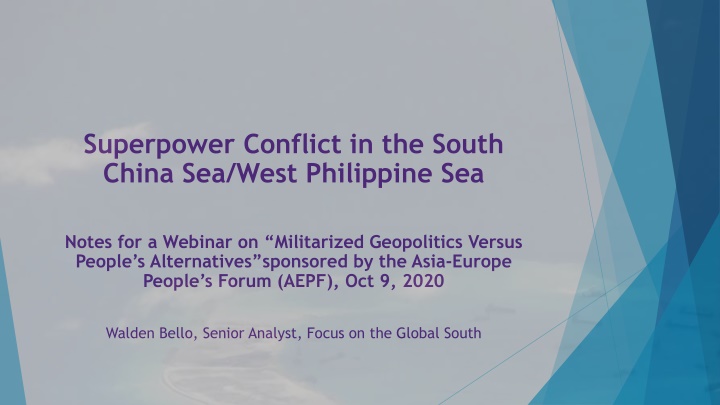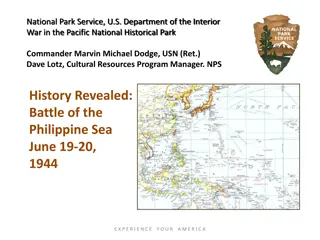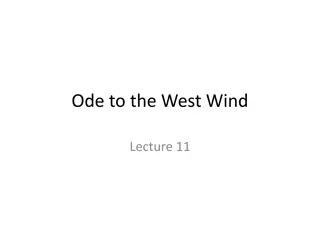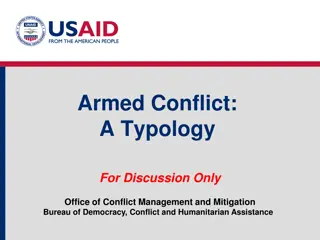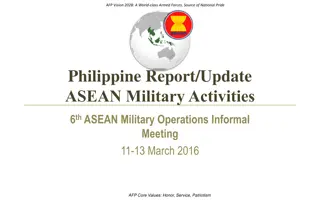Superpower Conflict in the South China Sea/West Philippine Sea
Hina engages in South China Sea drills while Walden Bello, Senior Analyst, sheds light on the superpower conflict in the region. Discussion highlights militarized geopolitics versus alternative perspectives in the South China Sea/West Philippine Sea, with a focus on the Asia-Europe Peoples Forum webinar held on Oct. 9, 2020. Explore the dynamics of the ongoing tensions and the quest for peaceful solutions in the region.
Uploaded on Mar 05, 2025 | 4 Views
Download Presentation

Please find below an Image/Link to download the presentation.
The content on the website is provided AS IS for your information and personal use only. It may not be sold, licensed, or shared on other websites without obtaining consent from the author.If you encounter any issues during the download, it is possible that the publisher has removed the file from their server.
You are allowed to download the files provided on this website for personal or commercial use, subject to the condition that they are used lawfully. All files are the property of their respective owners.
The content on the website is provided AS IS for your information and personal use only. It may not be sold, licensed, or shared on other websites without obtaining consent from the author.
E N D
Presentation Transcript
hina shoots across US bow with South China Sea drills - Nikkei Asia Superpower Conflict in the South China Sea/West Philippine Sea Notes for a Webinar on Militarized Geopolitics Versus People s Alternatives sponsored by the Asia-Europe People s Forum (AEPF), Oct 9, 2020 Walden Bello, Senior Analyst, Focus on the Global South
Id like to make three points at the outset: 1. The South China Sea (SCS) or what we in the Philippines call the West Philippine Sea (WPS) is one of the most dangerous places in the world today, the most likely site of a military confrontation between the US and China. As a Vietnamese official told me in 2014, A ship collision can immediately escalate into conventional war. 2. I strongly disapprove of China s unilaterally claiming 90 per cent of the Sea as its national territory, seizing maritime formations belonging to others, and fortifying them. That is imperial behavior pure and simple. 3. That having been said, China has valid strategic concerns in the SCS, which borders Southeastern China, where most of the country s industrial infrastructure is located.
Military Balance But before we go into that, I would like to make some comments on the military balance between the US and China. 1. Speaking comprehensively, US military might dwarfs China s. China is not even a peer competitor, to use a favorite term of the Pentagon. 2. The $250 billion China spent on its military in 2018 was far outstripped by the $649 billion military budget of the US, which accounted for 36 per cent of worldwide military spending. 3. The strategic nuclear force of China is puny compared to both those of the US and Soviet Union and has not experienced significant upgrading for a long time.
ake Ride Aboard USS Ronald Reagan and Carrier Air Wing Five - YouTube 4. The conventional warfare capabilities of the People s Liberation Army are grossly inferior to those of the US and are furthermore untested, compared to those of the US, which has been at war every year over the last 19 years. 5. While the People s Liberation Army Navy is large, its ships are qualitatively very inferior to those of the US, which is the most powerful Navy in the world. Aircraft carriers are the key measure of offensive capability, and here the US has 11 state of the art aircraft carriers, five of which are deployed in the Pacific. China, in contrast, has two Soviet- era aircraft carriers which are light years behind in design.
ensions Rise in the South China Sea: US, Chinese Maneuvers in Neighboring Waters | China s Strategic Dilemma Even the US Department of Defense admits that the Chinese military posture is one of the strategic defensive or strategic defense. China s military posture is determined by a strategic dilemma. This is the fact that large parts of the US military forces in the Western Pacific lie right on its doorstep, entrenched in bases and military facilities in Japan, South Korea, Guam, and the Philippines, or roaming the waters off the country s southeastern and eastern coasts in the form of the Seventh Fleet. Most of China s industrial infrastructure is located in this area, thus making them very vulnerable to destruction or at the very least to massive disruption in the event of war with the US.
he Pentagon's Fight Over Fighting China - POLITICO Magazine The US s Air-Sea Battle Doctrine In contrast to Beijing s strategic defensive stance, the fundamental strategic posture of the US is one of the strategic offensive or, in Orwellian language, forward defense through the permanent deployment of forces thousands of miles away from the American homeland, ready to strike at any challenger located in the East Asian landmass at a moment s notice. The operative battle doctrine of the US military is called Air-Sea Battle, which has China as its conceptual foe. As described by one analyst, Air Sea Battle calls for explosive and electronic strikes against inland command centers, radar systems and intelligence gathering facilities, raids against missile production and storage facilities and blinding operations against Chinese satellites. It also calls for cutting off China s seaborne trade with an eye toward exerting major stress on the Chinese economy and, eventually, internal stress.
Chinas Push-back Thrust China s moves in the South China Sea must be placed in this defensive context. China s spurious Nine-Dash-Line claims and its fortifying formations like Mischief Reef, which it seized from the Philippines, must be seen as parts of a strategic effort to push the American threat as far to the Western Pacific as possible so as to buy precious time and space for an effective defense against an American land-based and seaborne strike
Once More: Valid Concern, Wrong Approach Let me end by saying again that the Chinese strategic defensive concern is valid. What is wrong is the way China has acted to meet this concern, which has been through unilateral moves that violate the territorial and economic rights of its neighbors in the South China Sea: specifically, Vietnam, the Philippines, Malaysia, Indonesia. There is a better, more principled, and more effective way to satisfy Beijing s strategic defensive concerns, and that is, to work with its neighbors to create a demilitarized and denuclearized South China Sea, which we will discuss later.
A Four-Step Diplomatic Strategy to Solve the South China Sea Conflict
First, since strategic defense is a central motivation for China s behavior, the Philippines and China can agree to have bilateral talks on how to bring down the tension between the countries. The aim of these talks will not be to settle the territorial issue but to negotiate military de- escalation. One possible proposal could be a freeze in China s base-building activities in exchange for a freeze in the implementation of the latest military agreement that the Philippines has with the United States, the Enhanced Defense Cooperation Agreement (EDCA), which allows the US to use Philippine bases for its military buildup in that country.
Second, perhaps simultaneously with the Philippine-China bilateral talks, China should take seriously ASEAN s longstanding offer to hold multilateral talks on a code of conduct to govern the maritime behavior of all parties with claims to the South China Sea that they agreed to back in 2002.
Third, should these two confidence-building measures achieve some success, ASEAN and China could move on to negotiations to achieve significant demilitarization and denuclearization of the South China Sea, with the goal of coming up with a multilateral treaty that would be binding on all parties, including third parties like the United States. Such an agreement would, of course, necessitate abandoning EDCA on the part of the Philippines and dismantling of military structures in the South China Sea on the part of China. This agreement would complement two earlier ASEAN agreements the agreement to make ASEAN a Zone of Peace, Freedom, and Neutrality (ZOPFAN) and the Southeast Asia Nuclear Weapons Free Zone Agreement (SEANWFZ). It could also be the forerunner of an East Asia- wide collective security treaty that would replace the dangerous and volatile balance of power politics that simply promotes an uncontrollable arms race.
Finally, ASEAN and China could begin the process of resolving their competing claims on Exclusive Economic Zones and continental shelves and discussing joint development of fisheries and other resources. Given political sensitivities, these might be de facto arrangements instead of full-blown treaties or agreements, and would not necessitate the concerned parties formally abandoning their claims.
This route would not be easy to take. But its medium and long-term benefits for China would far outweigh what little benefits the unilateral course can reap for it and avoid its heavy costs. Beijing would distance itself from its image of intransigence, especially as it seeks to be respected as a global actor different in intent and methods from the western powers. This route would also open up a future of peace with its neighbors instead of one of endless tension. It would make it increasingly difficult for the US to justify its massive military presence in the western Pacific by convincing other countries that it is necessary in order to balance China. It provides a way out of a very volatile and destabilizing balance of power politics that could promote rather than prevent large-scale conflict, as it did in Europe in the years leading up to the First World War.
